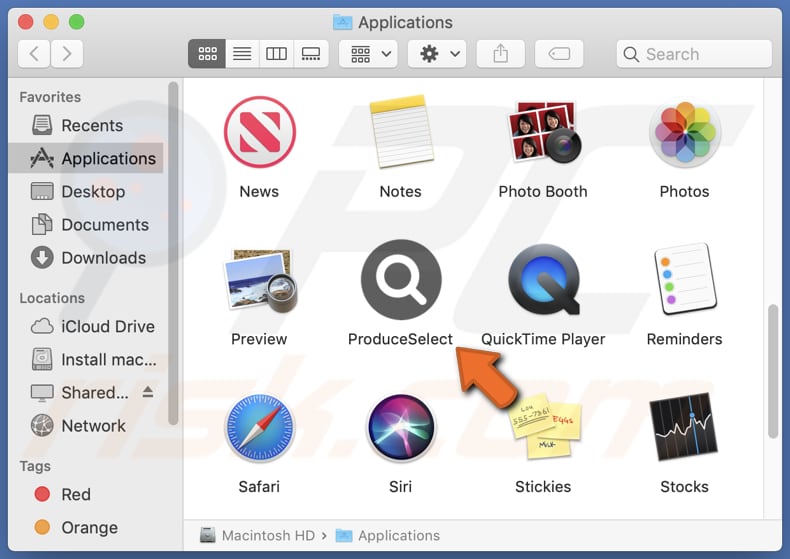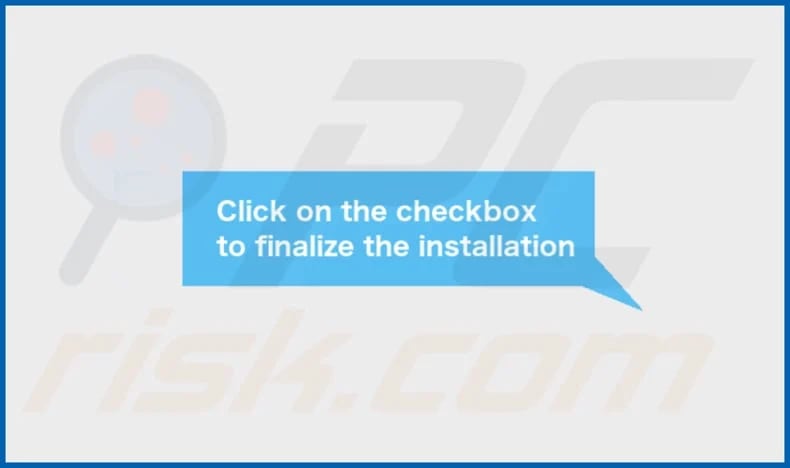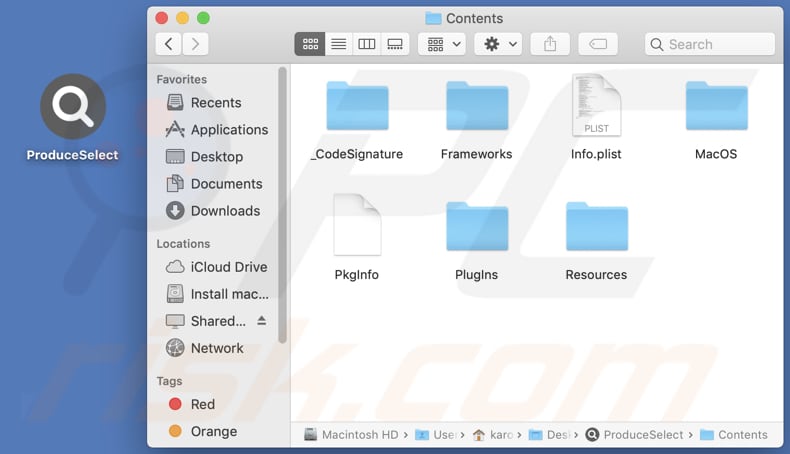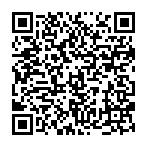How to remove ProduceSelect from your computer
![]() Written by Tomas Meskauskas on (updated)
Written by Tomas Meskauskas on (updated)
What kind of application is ProduceSelect?
In the course of examining ProduceSelect, we observed that the application exhibits unwanted advertisements. As a result, we have classified ProduceSelect as adware. It is crucial to emphasize that users often intentionally download and install such software. Furthermore, adware may be designed to gather various types of data.

ProduceSelect adware in detail
Users who engage with ProduceSelect may encounter a barrage of unwanted advertisements, ranging from banners to pop-ups. These ads can be annoying and lead to phishing websites, pages hosting malicious or unwanted apps, and other unreliable destinations. Some of these ads can be designed to trigger unwanted downloads.
Moreover, ProduceSelect, like many adware applications, poses significant risks to data privacy. Adware, including ProduceSelect, can be designed to collect diverse user data, such as browsing habits, search history, and personal information. This data collection raises privacy concerns, as the gathered information could be misused for malicious purposes, including identity theft.
In some instances, apps like ProduceSelect may also function as browser hijackers, altering the settings of web browsers/ This can lead to unwanted redirects, modifications to the default search engine, and changes to the homepage, further diminishing the user's control over their online experience.
In light of these issues, users are urged to exercise caution and consider the potential implications before installing apps like ProduceSelect.
| Name | Ads by ProduceSelect |
| Threat Type | Adware, Mac malware, Mac virus |
| Detection Names | Avast (MacOS:Adload-AG [Adw]), Combo Cleaner (Gen:Variant.Adware.MAC.AdLoad.13), ESET-NOD32 (A Variant Of OSX/Adware.Synataeb.H), Kaspersky (Not-a-virus:HEUR:AdWare.OSX.Adload.j), Full List (VirusTotal) |
| Additional Information | This application belongs to Adload malware family. |
| Symptoms | Your Mac becomes slower than normal, you see unwanted pop-up ads, you are redirected to dubious websites. |
| Distribution methods | Deceptive pop-up ads, free software installers (bundling), torrent file downloads. |
| Damage | Internet browser tracking (potential privacy issues), display of unwanted ads, redirects to dubious websites, loss of private information. |
| Malware Removal (Mac) | To eliminate possible malware infections, scan your Mac with legitimate antivirus software. Our security researchers recommend using Combo Cleaner. |
Conclusion
In conclusion, while ProduceSelect may initially appear useful, its identification as adware unveils a less favorable side to its functionality. The presence of disruptive and potentially misleading advertisements, coupled with concerns about data privacy and the potential for browser hijacking, raises red flags for users.
The risks associated with adware underscore the importance of thorough scrutiny before installing and interacting with seemingly benign software, emphasizing the need for a proactive approach to safeguarding both user experience and privacy in the digital landscape.
More examples of apps that are classified as adware are ProductSkyBlog, ConnectivityRepair, and ActiveAnalyser.
How did ProduceSelect install on my computer?
Adware is often bundled with seemingly harmless free software that users willingly download and install. Throughout the installation process, users may inadvertently ignore or dismiss optional checkboxes or settings that permit the installation of adware.
Furthermore, clicking on deceptive advertisements (e.g., push notifications from shady pages) can result in accidental adware installations. Sometimes, users cause unintentional installations via links or files received via email.
How to avoid installation of unwanted applications?
During software installations, carefully read each prompt. Pay close attention to checkboxes, terms, or options presented. Stick to reputable and official sources like official pages and app stores when downloading software. Regularly review and manage browser extensions. Remove any extensions that are not familiar or appear suspicious.
Exercise caution when interacting with online ads and pop-ups. Avoid clicking on suspicious ads. Regularly update software to the latest versions and employ reputable antivirus or anti-malware software. If your computer is already infected with ProduceSelect, we recommend running a scan with Combo Cleaner Antivirus for macOS to automatically eliminate this adware.
The message that appears after the installation of ProduceSelect:

ProduceSelect's installation folder:

Instant automatic Mac malware removal:
Manual threat removal might be a lengthy and complicated process that requires advanced IT skills. Combo Cleaner is a professional automatic malware removal tool that is recommended to get rid of Mac malware. Download it by clicking the button below:
▼ DOWNLOAD Combo Cleaner for Mac
By downloading any software listed on this website you agree to our Privacy Policy and Terms of Use. To use full-featured product, you have to purchase a license for Combo Cleaner. Limited seven days free trial available. Combo Cleaner is owned and operated by Rcs Lt, the parent company of PCRisk.com read more.
Quick menu:
- What is ProduceSelect?
- STEP 1. Remove ProduceSelect related files and folders from OSX.
- STEP 2. Remove ProduceSelect ads from Safari.
- STEP 3. Remove ProduceSelect adware from Google Chrome.
- STEP 4. Remove ProduceSelect ads from Mozilla Firefox.
Video showing how to remove ProduceSelect adware using Combo Cleaner:
ProduceSelect adware removal:
Remove ProduceSelect-related potentially unwanted applications from your "Applications" folder:

Click the Finder icon. In the Finder window, select "Applications". In the applications folder, look for "MPlayerX", "NicePlayer", or other suspicious applications and drag them to the Trash. After removing the potentially unwanted application(s) that cause online ads, scan your Mac for any remaining unwanted components.
Remove adware-related files and folders

Click the Finder icon, from the menu bar. Choose Go, and click Go to Folder...
 Check for adware generated files in the /Library/LaunchAgents/ folder:
Check for adware generated files in the /Library/LaunchAgents/ folder:

In the Go to Folder... bar, type: /Library/LaunchAgents/

In the "LaunchAgents" folder, look for any recently-added suspicious files and move them to the Trash. Examples of files generated by adware - "installmac.AppRemoval.plist", "myppes.download.plist", "mykotlerino.ltvbit.plist", "kuklorest.update.plist", etc. Adware commonly installs several files with the exact same string.
 Check for adware generated files in the ~/Library/Application Support/ folder:
Check for adware generated files in the ~/Library/Application Support/ folder:

In the Go to Folder... bar, type: ~/Library/Application Support/

In the "Application Support" folder, look for any recently-added suspicious folders. For example, "MplayerX" or "NicePlayer", and move these folders to the Trash.
 Check for adware generated files in the ~/Library/LaunchAgents/ folder:
Check for adware generated files in the ~/Library/LaunchAgents/ folder:

In the Go to Folder... bar, type: ~/Library/LaunchAgents/

In the "LaunchAgents" folder, look for any recently-added suspicious files and move them to the Trash. Examples of files generated by adware - "installmac.AppRemoval.plist", "myppes.download.plist", "mykotlerino.ltvbit.plist", "kuklorest.update.plist", etc. Adware commonly installs several files with the exact same string.
 Check for adware generated files in the /Library/LaunchDaemons/ folder:
Check for adware generated files in the /Library/LaunchDaemons/ folder:

In the "Go to Folder..." bar, type: /Library/LaunchDaemons/

In the "LaunchDaemons" folder, look for recently-added suspicious files. For example "com.aoudad.net-preferences.plist", "com.myppes.net-preferences.plist", "com.kuklorest.net-preferences.plist", "com.avickUpd.plist", etc., and move them to the Trash.
 Scan your Mac with Combo Cleaner:
Scan your Mac with Combo Cleaner:
If you have followed all the steps correctly, your Mac should be clean of infections. To ensure your system is not infected, run a scan with Combo Cleaner Antivirus. Download it HERE. After downloading the file, double click combocleaner.dmg installer. In the opened window, drag and drop the Combo Cleaner icon on top of the Applications icon. Now open your launchpad and click on the Combo Cleaner icon. Wait until Combo Cleaner updates its virus definition database and click the "Start Combo Scan" button.

Combo Cleaner will scan your Mac for malware infections. If the antivirus scan displays "no threats found" - this means that you can continue with the removal guide; otherwise, it's recommended to remove any found infections before continuing.

After removing files and folders generated by the adware, continue to remove rogue extensions from your Internet browsers.
Remove malicious extensions from Internet browsers
 Remove malicious Safari extensions:
Remove malicious Safari extensions:

Open the Safari browser, from the menu bar, select "Safari" and click "Preferences...".

In the preferences window, select "Extensions" and look for any recently-installed suspicious extensions. When located, click the "Uninstall" button next to it/them. Note that you can safely uninstall all extensions from your Safari browser - none are crucial for regular browser operation.
- If you continue to have problems with browser redirects and unwanted advertisements - Reset Safari.
 Remove malicious extensions from Google Chrome:
Remove malicious extensions from Google Chrome:

Click the Chrome menu icon ![]() (at the top right corner of Google Chrome), select "More Tools" and click "Extensions". Locate all recently-installed suspicious extensions, select these entries and click "Remove".
(at the top right corner of Google Chrome), select "More Tools" and click "Extensions". Locate all recently-installed suspicious extensions, select these entries and click "Remove".

- If you continue to have problems with browser redirects and unwanted advertisements - Reset Google Chrome.
 Remove malicious extensions from Mozilla Firefox:
Remove malicious extensions from Mozilla Firefox:

Click the Firefox menu ![]() (at the top right corner of the main window) and select "Add-ons and themes". Click "Extensions", in the opened window locate all recently-installed suspicious extensions, click on the three dots and then click "Remove".
(at the top right corner of the main window) and select "Add-ons and themes". Click "Extensions", in the opened window locate all recently-installed suspicious extensions, click on the three dots and then click "Remove".

- If you continue to have problems with browser redirects and unwanted advertisements - Reset Mozilla Firefox.
Frequently Asked Questions (FAQ)
What harm can adware cause?
The presence of adware on your system can result in a compromised web browsing experience and may impair your system's performance.
What does adware do?
Adware is software that displays unwanted advertisements, often in the form of pop-ups or banners, disrupting the user's online experience. It can also lead to privacy concerns by collecting user data and, in some cases, hijack browsers.
How do adware developers generate revenue?
Adware developers commonly earn income by endorsing a variety of products, websites, or services. The majority of their revenue is typically derived from participating in affiliate programs, which reward developers for directing user engagement, such as website visits, purchases, or sign-ups.
Will Combo Cleaner remove ProduceSelect adware?
Combo Cleaner will perform a scan of your computer and remove any installed applications classified as adware. It is important to realize that manual removal may be ineffective, as certain files could persist in the system. Thus, it is recommended to remove adware using Combo Cleaner.


▼ Show Discussion